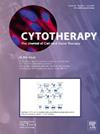Generation of HLA-DR+CD1c-CD14-XCR1+ dendritic cells expressing CAR from induced pluripotent cells as an alternative treatment for cancer
IF 3.7
3区 医学
Q2 BIOTECHNOLOGY & APPLIED MICROBIOLOGY
引用次数: 0
Abstract
Background & Aim
Immunotherapy based on T cells expressing CARs has been shown to be a promising strategy for treating hematological tumors. However, similar results have not been reported for solid tumors. Therefore, other immune cells have been explored to express CARs for immunotherapy applications. Dendritic cells are a heterogeneous cell population specialized in antigen presentation, with great migratory capacity, representing good candidates for solid tumor therapies. Due to their scarcity in peripheral blood and low proliferative potential, an "off-the-shelf" source such as induced pluripotent stem cells is needed to enable their use in cell therapy. Thus, our aim is to develop iPSC-DCs expressing CAR as an alternative treatment for solid tumors.
Methodology
Electroporation of the piggyBac transposon system was utilized to insert a CAR into an iPSC line. Differentiation of CAR-iPSCs was carried out following an established step-by-step protocol: (A) embryoid body formation, (B) generation of hematopoietic stem-like cells and (C) production of immune myeloid-like cells. Subsequently, differentiation into myeloid immune cells was induced using GM-CSF and IL-4 after 30 days. Flow cytometry was employed to analyze the phenotype of the differentiated cells. Co-culture of CAR-iPSC-DC cells with T cells was performed to observe induction of T cell proliferation.
Results
We have achieved an initial transfection efficiency of 2%. Sequential cell sorting increased the purity of CAR-expressing cells to 95%, with stable expression maintained for over 40 days. We obtained differentiated cells with typical myeloid immune cell morphology, including a few macrophage-like cells, with large cytoplasmic vacuoles and numerous cells with dendrite projections, closely resembling DC morphology. Moreover, cells presented a HLA-DR+CD64lowXCR1high phenotype, similar to cDC1 found in PB. Preliminary data showed that these cDC1-like cells are able to induce CD3+ T cell proliferation in vitro, similar to that observed with moDCs, reinforcing their similarity with PB DCs.
Conclusion
This study highlights the feasibility of using iPSC-derived DCs as an "off-the-shelf" cell source for cancer immunotherapies. The observed cDC1-like phenotype and the ability of these cells to stimulate CD3+ T cell proliferation in vitro provide a strong foundation for further investigation into their functionality and antitumor potential. The next steps include in vitro and in vivo analysis of cDC1-like function and their antitumor effects.
诱导多能细胞生成表达CAR的HLA-DR+CD1c-CD14-XCR1+树突状细胞作为癌症的替代治疗方法
背景,基于表达car - T细胞的免疫治疗已被证明是治疗血液肿瘤的一种有前途的策略。然而,在实体瘤中没有类似的结果。因此,其他免疫细胞已被探索表达car - t用于免疫治疗。树突状细胞是一种异质细胞群,专门用于抗原呈递,具有很强的迁移能力,是实体肿瘤治疗的良好候选者。由于它们在外周血中的稀缺性和低增殖潜力,需要一种“现成的”来源,如诱导多能干细胞,以使其能够用于细胞治疗。因此,我们的目标是开发表达CAR的iPSC-DCs作为实体瘤的替代治疗方法。方法利用电穿孔法将piggyBac转座子系统插入iPSC细胞系。CAR-iPSCs的分化是按照既定的分步方案进行的:(A)胚状体形成,(B)造血干细胞样细胞的产生,(C)免疫髓样细胞的产生。30天后用GM-CSF和IL-4诱导分化为髓系免疫细胞。流式细胞术分析分化细胞的表型。CAR-iPSC-DC细胞与T细胞共培养,观察其对T细胞增殖的诱导作用。结果获得了2%的初始转染效率。序贯细胞分选使car表达细胞的纯度提高到95%,稳定表达维持40天以上。我们获得的分化细胞具有典型的髓系免疫细胞形态,包括少数巨噬细胞样细胞,具有大的细胞质液泡和大量具有树突突起的细胞,与DC形态非常相似。此外,细胞呈现HLA-DR+ cd64lowxcr1高表型,类似于PB中发现的cDC1。初步数据显示,这些cdc1样细胞能够在体外诱导CD3+ T细胞增殖,与moDCs观察到的结果相似,加强了它们与PB dc的相似性。结论本研究强调了利用ipsc衍生的dc作为癌症免疫治疗的“现成”细胞来源的可行性。观察到的cdc1样表型和这些细胞在体外刺激CD3+ T细胞增殖的能力为进一步研究它们的功能和抗肿瘤潜力提供了坚实的基础。下一步包括体外和体内cdc1样功能及其抗肿瘤作用的分析。
本文章由计算机程序翻译,如有差异,请以英文原文为准。
求助全文
约1分钟内获得全文
求助全文
来源期刊

Cytotherapy
医学-生物工程与应用微生物
CiteScore
6.30
自引率
4.40%
发文量
683
审稿时长
49 days
期刊介绍:
The journal brings readers the latest developments in the fast moving field of cellular therapy in man. This includes cell therapy for cancer, immune disorders, inherited diseases, tissue repair and regenerative medicine. The journal covers the science, translational development and treatment with variety of cell types including hematopoietic stem cells, immune cells (dendritic cells, NK, cells, T cells, antigen presenting cells) mesenchymal stromal cells, adipose cells, nerve, muscle, vascular and endothelial cells, and induced pluripotential stem cells. We also welcome manuscripts on subcellular derivatives such as exosomes. A specific focus is on translational research that brings cell therapy to the clinic. Cytotherapy publishes original papers, reviews, position papers editorials, commentaries and letters to the editor. We welcome "Protocols in Cytotherapy" bringing standard operating procedure for production specific cell types for clinical use within the reach of the readership.
 求助内容:
求助内容: 应助结果提醒方式:
应助结果提醒方式:


